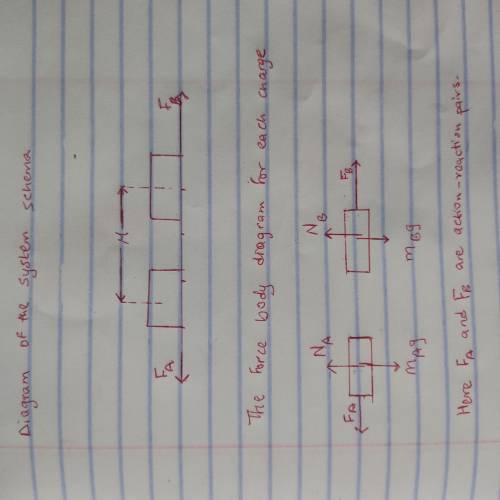
Physics, 11.02.2021 22:50 ShianHagen5
Two objects are located on an airtrack (you may assume there is no friction). The magnitude of the charge on object A is 5 times higher than on object B, and object A also has a 6 times higher mass than object B (the picture is not scale or necessarily in the correct direction). Each object is accelerating in the direction of the arrows.
a. Draw a system schema.
b. Draw the force body diagrams for each charge and identify all newton 3d law pairs.
c. Write (in symbolic form) expressions for the net force on each object.
d. Find how many times faster/slower the acceleration of object B is compared to object A?

Answers: 2
Another question on Physics

Physics, 21.06.2019 17:10
An air-standard stirling cycle operates with a maximum pressure of 600 psia and a minimum pressure of 10 psia. the maximum volume of the air is 10 times the minimum volume. the temperature during the heat rejection process is 100°f. calculate the specific heat added to and rejected by this cycle, as well as the net specific work produced by the cycle. use constant specific heats at room temperature. the properties of air at room temperature are r
Answers: 2

Physics, 22.06.2019 01:10
Suppose that two tanks, 1 and 2, each with a large opening at the top, contain different liquids. a small hole is made in the side of each tank at the same depth 1.57 m below the liquid surface, but the hole in tank 2 has 2.49 times the cross-sectional area of the hole in tank 1. (a) what is the ratio ρ1/ρ2 of the densities of the liquids if the mass flow rate is the same for the two holes? (b) what is the ratio rv1/rv2 of the volume flow rates from the two tanks? (c) at one instant, the liquid in tank 1 is 14.9 cm above the hole. if the tanks are to have equal volume flow rates, what height above the hole must the liquid in tank 2 be just then?
Answers: 3

Physics, 22.06.2019 02:00
The image shows a pendulum in simple harmonic motion the pendulum starts at a and swing to e
Answers: 3

Physics, 22.06.2019 02:50
An alligator swims to the left with a constant velocity of 5 \,\dfrac{\text{m}}{\text s}5 s m ? 5, space, start fraction, m, divided by, s, end fraction. when the alligator sees a bird straight ahead, the alligator speeds up with a constant acceleration of 3 \,\dfrac{\text {m}}{\text s^2}3 s 2 m ? 3, space, start fraction, m, divided by, s, start superscript, 2, end superscript, end fraction leftward until it reaches a final velocity of 35 \,\dfrac{\text {m}}{\text s}35 s m ? 35, space, start fraction, m, divided by, s, end fraction leftward. how many seconds does it take the alligator to speed up from 5 \,\dfrac{\text {m}}{\text s}5 s m ? 5, space, start fraction, m, divided by, s, end fraction to 35 \,\dfrac{\text {m}}{\text s}35 s m ? 35, space, start fraction, m, divided by, s, end fraction?
Answers: 3
You know the right answer?
Two objects are located on an airtrack (you may assume there is no friction). The magnitude of the c...
Questions



Mathematics, 07.06.2020 06:57

Mathematics, 07.06.2020 06:57

Biology, 07.06.2020 06:57


Mathematics, 07.06.2020 06:57











Mathematics, 07.06.2020 06:57


English, 07.06.2020 06:57









